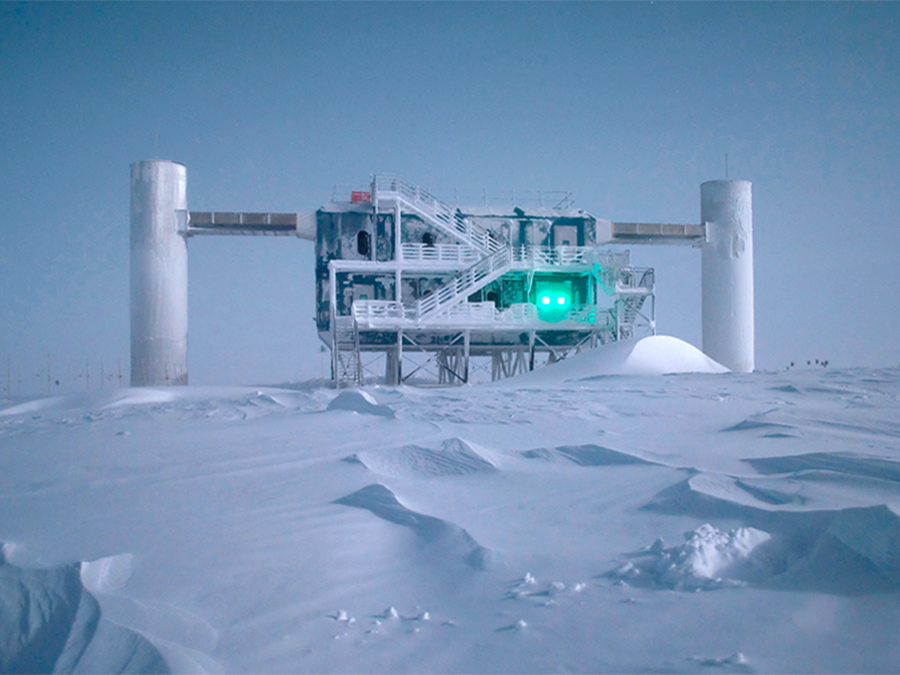South Pole observatory IceCube delivers first indications of neutrinos from cosmic accelerators
Racing particles from space

A wide variety of particles perpetually pound onto the Earth’s atmosphere. Most of these particles, like protons, electrons or helium nuclei have a certain mass and carry an electrical charge. When they collide with other particles or are deflected by the cosmic magnetic fields, the sun or the Earth, they alter their path and energy.
Not so, the uncharged and extremely light neutrinos: They speed right through all mater, more or less undisturbed. Every second billions of neutrinos pass through each square centimeter of the Earth’s surface. The vast majority of these elementary particles are created in decay and transformation processes within the sun or in the Earth’s atmosphere.
Neutrinos that stem from outside our solar system, from the outer reaches of our galaxy or even further away, are much rarer. These astrophysical neutrinos are highly interesting for physicists. They offer clues to the powerful cosmic objects they stem from: supernovas, black holes, pulsars, active galactic cores and other extreme extragalactic phenomena.
Now the scientists of the IceCube experiment, which includes researchers from the Cluster of Excellence Universe at the TUM, report they have observed, for the first time, high-energy neutrinos. The 28 events were recorded between May 2010 and May 2012. Each of these neutrinos had an energy of over 50 tera-electron volts (TeV). That is a thousand fold more energy than any neutrino from a terrestrial accelerator has ever reached.
“These are the first indications of neutrinos from outside our solar system,” says TUM physicist Professor Elisa Resconi, who is a member of the IceCube collaboration. “These events can be explained neither by causes like atmospheric neutrinos, nor by other high-energy events like muons created in the Earth’s atmosphere during interactions with cosmic rays.”
After observing hundreds of thousands of atmospheric neutrinos, the researchers are finally convinced they have proven the existence of neutrinos that fulfill their expectations of astrophysical neutrinos that in all likelihood stem from cosmic accelerators. “Now we must determine where these neutrinos come from and how they are created. We are at the frontier of a new astronomy with neutrinos,” says Elisa Resconi.
The IceCube observatory is melted into the permafrost of the South Pole, an installation that was completed in 2010 following seven years of construction. At one cubic kilometer in size, it is the largest neutrino detector worldwide. 86 vertical wire ropes with a total of 5160 optical sensors were sunk 1450 to 2450 meters into the ice. IceCube detects neutrinos via tiny flashes of blue light, so called-Cherenkov radiation, which appears when neutrinos interact with ice, generating a shower of charged particles. The observatory is run by an international consortium under the direction of the University of Wisconsin, Madison (USA). The research team comprises some 250 scientists and engineers from USA, Germany, Sweden, Switzerland, Japan and other countries.
Publication:
Evidence for High-Energy Extraterrestrial Neutrinos at the IceCube Detector, IceCube Collaboration, Science, Vol. 342 no. 6161, 22. Nov. 2013 – DOI: 10.1126/science.1242856
Contact:
Prof. Dr. Elisa Resconi
Technische Universität München
Experimental physics of cosmic particles
Cluster fo Excellence Origin and Structure of the Universe
Boltzmannstr. 2, 85748 Garching, Germany
Tel.: +49 89 35831 7120 – E-Mail
Technical University of Munich
Corporate Communications Center
- Andreas Battenberg
- battenberg@zv.tum.de
- presse@tum.de
- Teamwebsite